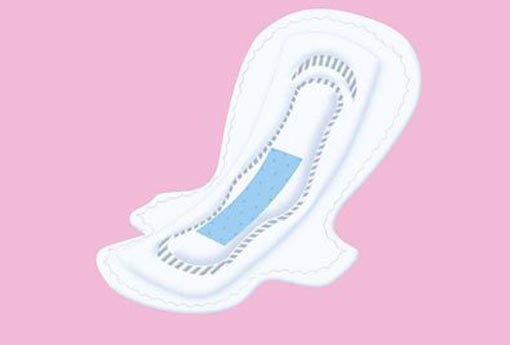Basic Information
Foreign name: sanitary napkins or sanitary pads
Chinese name: sanitary napkin
Material: cotton, non-woven fabric, pulp, etc.
Invention history
The prototype of sanitary napkins Egypt: using softened papyrus leaves as tampons. In 1550 BC, there were records of putting soft cloths into women's vaginas to prevent pregnancy in Egypt. Experts speculate that these soft cloths were also used to deal with menstruation, which is probably the first generation of "sanitary napkins" that we can know. China: Chinese women use a long white cloth towel under their body to absorb blood during menstruation. After changing, they wash Greece with clean water and alum: it is wrapped in linen on wood and used as a tampon. Africa: In some places, women use fluffy feathers and pieces of cloth to pad their lower bodies, and collect the used feathers and pieces of cloth in small wooden barrels. United States: The modern version of sanitary napkins is said to have been invented by an American man who loved his wife so much, who stumbled upon the creation of long strips of cotton by wrapping clean cotton fibers and absorbent pulp in a fine cloth. The pad can effectively relieve the pain and inconvenience of the wife's menstrual period. this kind of cotton pads became popular from European and American countries in the 1940s, and gradually developed into the use of disposable materials. There is also a saying that women in ancient times, because there was no sanitary napkin to use, women in the cave-dwelling era sometimes directly used Sea sponges, or use grass and other things as sanitary napkins.
Washable stage In the nineteenth century, it entered the stage of "washable sanitary napkins". Women would put cotton wool or rags into bags and make so-called "rag bags" as sanitary napkins. In addition to using rag bags, women of that era would wear a "hygienic apron" between the hips and the clothes (a rubber pad the size of a half apron, pinned a piece of cotton cloth, and then wrapped around the waist, the cotton cloth on the rubber pad goes around the buttocks genitals, and then use safety pins or clips), so it is always very inconvenient on the days when menstruation comes.
Disposable stage until the invention of "fiber cotton" in World War I, which was added to other product applications, including disposable bandages and their extensions. And nurses will start to use gauze surgical cotton or cheese-wrapped cloth to make "disposable sanitary napkins" by themselves, and sanitary napkins were born. In the twentieth century, some companies also began to produce sanitary napkins, and women used safety pins or tied sanitary napkins to fasten the sanitary napkins (a "physiological belt" is similar to a garter belt tied around the waist, with a belt around the pubic area in the front. , the back is also wrapped around the buttocks with a belt, and then the sanitary napkin is fixed with safety pins or sling clips) (another thing is, the American female nurses who served in France during the First World War. Those women in light white clothes are Pioneers of modern working women. Even during menstruation, they still want to maintain that elegance, agility and ability, so they made a bold experiment with menstrual products: using bandages and medicated cotton to make the first sanitary napkins, The invention of sanitary napkins is undoubtedly great, and its significance is even more trans-generational. It is precisely because of this that it is known as one of the "Top Ten Inventions that Affect Humanity in the 20th Century".) In 1921, the world's The first disposable sanitary napkin came from Kimberly-Clark in the United States (Kimberly-Clark, brand "Kotex"). In 1927, Johnson & Johnson also launched a sanitary napkin brand - Modess. In the 1970s, the sanitary napkin's The evolution has made a major breakthrough, that is, the birth of "self-adhesive self-adhesive sanitary napkin". Between 1989 and 1990, the "Happy Butterfly Wings" and "Silk Sanitary Pads" changed and wrote the history of sanitary pads.
main classification
According to national standards, sanitary napkins can be divided into three categories from the surface material:
Dry mesh sanitary napkins refer to sanitary napkins whose surface layers are made of various perforated films, mainly polyethylene, commonly known as PE film;
Cotton soft sanitary napkins refer to sanitary napkins whose surface layers are made of various non-woven materials, mainly polypropylene, commonly known as PP.
Pure cotton sanitary napkins refer to sanitary napkins whose surface layer is made of pure cotton material, mainly pure cotton non-woven fabrics.
structure
The structure of the sanitary napkin can be divided into surface layer, absorbent core, bottom layer and the materials of each layer are bonded with hot melt adhesive. The surface layer is the part that is in direct contact with the skin, and its material is soft, and the weave and indentation on the surface can affect the reverse osmosis effect (dryness) of the sanitary napkin. PE perforated film surface layer and cotton surface layer are the two most commonly used materials. The PE surface layer and the microporous design make it difficult for menstrual blood to re-infiltrate and make users feel dry. However, the material is hard, and some users may cause Allergic reaction; due to the improved design of cotton absorption, and the availability of perforated and composite materials, the market share after 2001 is gradually higher than that of sanitary napkins with PE surface. The inner layer is mainly composed of high-molecular polymer and high-molecular polymer composite paper formed by cotton, non-woven fabric, pulp or a composite of the above materials, which is used to absorb the outflowing menstrual blood. The design of the side is mainly used to prevent side leakage, because it will present a certain angle with the sanitary napkin body during use, and it is easier to rub against the groin, so the sanitary napkin with the side of the soft material is more favored by women. The adhesive of the sanitary napkin is an impermeable material, which can retain the menstrual blood in the sanitary napkin. In the 1970s and 1980s, a self-adhesive adhesive was developed to facilitate the fixing of the sanitary napkin on the underwear.
Instructions
Usage 1 of sanitary napkins: One is a long strip without ears on both sides. For this kind of sanitary napkin, just tear the packaging bag, take out the sanitary napkin and unfold it, and then tear off the paper tape on the reverse side of the sanitary napkin (this tape is used to prevent the sanitary napkin from sticking during packaging, and has no other use. After tearing it off, you can Throw it away), align the glued side of the sanitary napkin with the crotch of the underwear and stick it on the underwear, and the sanitary napkin is placed. There is an "ear", the usage of this sanitary napkin is to open the package, take out the sanitary napkin, first tear off the paper tape in the middle, and stick the glued side to the middle of the crotch of the underwear, and the two ears are aligned with the narrowest part of the crotch. place. Then tear off the small piece of sticker on the back of the "ear" on the left side, the "ear" is folded back from the narrowest part of the left side of the panties until the front of the crotch of the panty is glued firmly, and then tear off the sticker on the back of the "ear" on the other side , From the right side of the narrowest part of the crotch of the underwear, the front of the crotch of the underwear is fixed. Because of the adhesive adhesion at the bottom of the sanitary napkin and the fixing of the "ears" from both sides, the sanitary napkin will be firmly adhered to the underwear. At the bottom, it is more difficult to shift when moving.
Variety selection
When women are menstruating, the sensitive areas of the skin are most vulnerable to damage. Surveys show that 73% of women experience local itching and burning during menstruation. This is mostly caused by the use of impermeable sanitary napkins. Therefore, it is very important to choose the right sanitary napkin in order to have a safe period. Sanitary napkins are generally composed of three parts: surface layer, absorbent layer and bottom layer, and the materials and functions of these three parts should be considered when using.
First, the surface layer should choose a dry mesh funnel type. The surface layer is dry so that the local skin will not suffer from moisture; the funnel-shaped design is better than the barrel-shaped design, and the infiltrated liquid is not easy to return.
Second, the middle layer should be breathable and contain a high-efficiency gel layer. The sanitary napkin with a high-efficiency gel layer can condense the infiltrated liquid into a gel-like shape, which will not re-infiltrate after being pressed, and the surface will not feel sticky.
Third, the bottom layer is preferably made of breathable materials, which can allow gaseous water molecules to pass through smoothly, so as to achieve the effect of timely discharge of moisture, effectively reducing the effect of sanitary napkins and the body to discharge moisture, effectively reducing The dampness and sultry heat between the sanitary napkin and the body keep it dry and fresh.
In addition, sanitary napkins can also be selected according to menstrual volume. Generally speaking, menorrhagia includes two meanings: one is excessive bleeding (the normal amount is not more than 100 ml); the other is excessive menstrual time (normal is 7 days). Menorrhagia is often caused by irregular endometrial shedding and endometrial hyperplasia, or functional uterine bleeding, uterine fibroids, bleeding disorders, liver dysfunction and other diseases, or is affected by external factors, such as Pay attention to menstrual hygiene, exposure to cold and heat, excessive mental stress and other reasons. For the case of excessive menstrual flow, there are already specially targeted large-volume daily and extended night sanitary napkins on the market, such as Hushubao Sweet Sleeping 400 Ultra-Long Night and other extended and thickened sanitary napkins.
In addition, you can be more diligent and replace more, it is not particularly difficult. For before and after menstruation, especially in the last day or two, when the menstrual flow is low, you can say goodbye to heavy sanitary napkins and choose daily-use types or some mini sanitary napkins on the market. The so-called oligomenorrhea (menstrual blood is in a state of dripping), a woman over 18 years old who has not had a menstrual period, or a normal menstrual period in the past but no menstruation for more than 3 consecutive months is called amenorrhea. It is often caused by systemic chronic diseases, such as severe anemia, liver disease, diabetes, schistosomiasis, hookworm disease, etc., as well as malnutrition, endocrine disorders, partial uterine hypoplasia, and genital tuberculosis. In addition, strong stimulation or damage to the brain, such as excessive fatigue, can also cause amenorrhea. However, amenorrhea during pregnancy and lactation is a normal physiological phenomenon.
Precautions
Unhygienic women have poor resistance during menstruation, and if they do not pay attention to nursing, they will cause various inappropriateness of the body. According to expert statistics in the early years, 38% of people who use unqualified sanitary napkins will suffer from serious gynecological diseases; 73% of women will feel local skin itching, burning and burning during menstruation; about 80% of women also Symptoms such as high fever, headache, and abdominal pain may occur. The reason is that the external environment of the female pelvis, uterus, and cervix are all connected, and this structure makes the female reproductive system vulnerable to the invasion of external pathogens. Especially during menstruation, the resistance of the reproductive organs is reduced, and it is more fragile than usual. If you use substandard sanitary napkins, you are prone to infection. Menstrual blood is rich in nutrients, and thus becomes a "culture medium" for bacteria to thrive. An experiment showed that after 2 hours of continuous use of ordinary sanitary napkins, the total number of bacteria on the surface can reach 107 per square centimeter.
Sanitary napkins that are changed and washed frequently must focus on two points on the premise of ensuring that they are basically free of bacteria: good absorption rate and high air permeability, otherwise it may create a closed and non-dry environment for the private parts and cause bacteria to breed into the human body . If it is a low-quality sanitary napkin, it may greatly increase the chance of inflammation because the material contains impurities and has poor absorption. It is best for women to change the sanitary napkin frequently. It is best to change it every 2 to 3 hours when the flow is high, and it should not exceed 4 to 5 hours when the flow is low. Even if you have a period, you should clean the vulva every day. . Before using the replacement, be sure to wash your hands to prevent germs from spreading to the sanitary napkin.
Sanitary napkin selection method Sanitary napkins on the market are mainly divided into dry and cotton soft from the surface material. How to choose according to the characteristics of personal constitution and physiological period, which is not small. Dry mesh sanitary napkins use a chemical fiber material called "perforated film", which is characterized by a faster rate of water permeability, but chemical fibers may increase the risk of allergies. Most of the cotton mesh is non-woven, which is extracted from cotton, which is more natural and soft, and is suitable for most women. Sensitive skin should choose products with soft cotton surface to avoid allergies and excessive friction. However, if you need to travel or ride for a long time in the car, you may wish to use a dry surface to accelerate the absorption of menstrual blood, so as to reduce the humidity and stuffiness and reduce the risk of infection.
Tampon usage A built-in tampon is a menstrual sanitary napkin that is placed inside the vagina. It gently adheres to the vaginal wall and absorbs all the menstrual blood in the body. So it can prevent leakage and keep the body clean and dry. Because the tampon is plugged into the vagina to form a closed space, if it is not replaced regularly, it is easy to lead to the rapid growth of normal bacteria in the vagina, resulting in the phenomenon of infection and inflammation. When the amount of menstrual blood is too small, if you do not change the tampon diligently, there will be a reverse flow of menstrual blood after long-term use, which will cause gynecological diseases such as endometriosis. If used, it should be changed every 2 to 3 hours.
Toxic sanitary napkins
In March 2014, "Consumer Reports" submitted 10 major brand sanitary napkin products including Hushubao, Sophie, Jiaoshuang, ABC, Anerle, Gaojiesi and Aiyouyou, in order to improve the safety and practicability. Some guidance for female consumers. The test results showed that no formaldehyde was detected in all products submitted for inspection. At the same time, all products were detected with migratory optical brighteners, ranging from 54.9 mg/kg-386 mg/kg. Sanitary napkin national standard "GB/T 893" -2008 Sanitary Napkins (including Sanitary Pads)" does not make any regulations on substances such as formaldehyde and fluorescent whitening agents in sanitary napkins, and both their content and detection methods are in a blank state. European and American countries also do not limit the content of fluorescent whitening agents in sanitary napkin products. The toxicity of the fluorescent whitening agent is generally expressed by LC50. The LC50 of the fluorescent whitening agent CBS (or CBS-X) commonly used in detergents is about 5000mg/kg, and the amount is very small, which cannot reach the toxic range. Larger ones may lead to the development of cancer cells.








